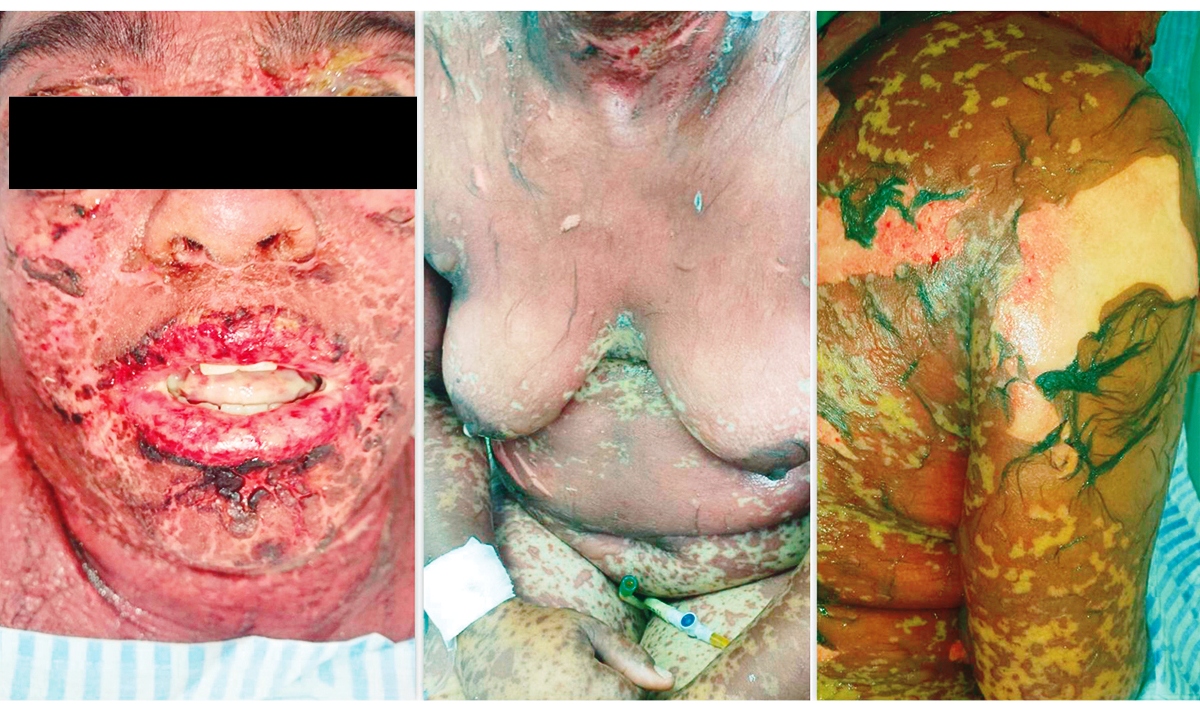A 46-year-old woman infected with human immunodeficiency virus (HIV) under treatment with zidovudine, lamivudine, and efavirenz, was admitted with disseminated erythematous-violaceous macules and bullous lesions in the neck, anterior chest, and palmoplantaris regions; eroded lesions in the oral cavity; and ocular mucosa involvement. She reported an episode of fever one month earlier, which was treated with metamizole. Within 15 days, she developed cutaneous lesions associated with pharyngitis; she was administered azithromycin and then amoxicillin-potassium clavulanate.
On admission, laboratory tests showed a C reactive protein (CRP) level of 7.6mg/L, gamma-glutamyl transferase level of 390/L, and proteinuria of 30g/L. The initial conduct was suspension of all drugs and hydrocortisone(4mg/kg/day) administration
A week later, she developed erosions affecting >30% of her body surface area, including the oral cavity, ocular conjunctiva, and genitalia (Figure 1). Laboratory tests showed a CRP level of 11.7mg/L, albumin level of 1.8g/dL, ESR (erythrocyte sedimentation rate) 95mm, and proteinuria of 100g/L. The rash was characteristic of toxic epidermal necrolysis (TEN).
Human intravenous immunoglobulin (IVIg) (40g/day) was initiated for 3 days. One week after initiating IVIg, she showed considerable improvement in her dermal condition, with no new lesions and re-epithelialization in several areas (Figure 2).
HIV infection increases TEN susceptibility compared to that in the general population11. Harris V, Jackson C, Cooper A. Review of toxic epidermal necrolysis. Int J Mol Sci. 2016;17(12):2135.. Sulfamethoxazole-trimethoprim use is the main cause for TEN. Among anti-retroviral drugs, nevirapin is more frequently associated with TEN22. Tseng J, Maurer T, Mutizwa MM. HIV-associated toxic epidermal necrolysis at San Francisco General Hospital: A 13-year retrospective review. J Int Assoc Provid AIDS Care. 2017;16(1):37-41.,33. Duong TA, Valeyrie-Allanore L, Wolkenstein P, Chosidow O. Severe cutaneous adverse reactions to drugs. Lancet. 2017;390(10106):1996-2011.. In this case, the patient was not administered any of the above mentioned drugs. The possible medicines involved are metamizole and amoxicillin+clavulanate.
REFERENCES
-
1Harris V, Jackson C, Cooper A. Review of toxic epidermal necrolysis. Int J Mol Sci. 2016;17(12):2135.
-
2Tseng J, Maurer T, Mutizwa MM. HIV-associated toxic epidermal necrolysis at San Francisco General Hospital: A 13-year retrospective review. J Int Assoc Provid AIDS Care. 2017;16(1):37-41.
-
3Duong TA, Valeyrie-Allanore L, Wolkenstein P, Chosidow O. Severe cutaneous adverse reactions to drugs. Lancet. 2017;390(10106):1996-2011.
Publication Dates
-
Publication in this collection
Sep-Oct 2018
History
-
Received
19 Dec 2017 -
Accepted
25 Jan 2018





